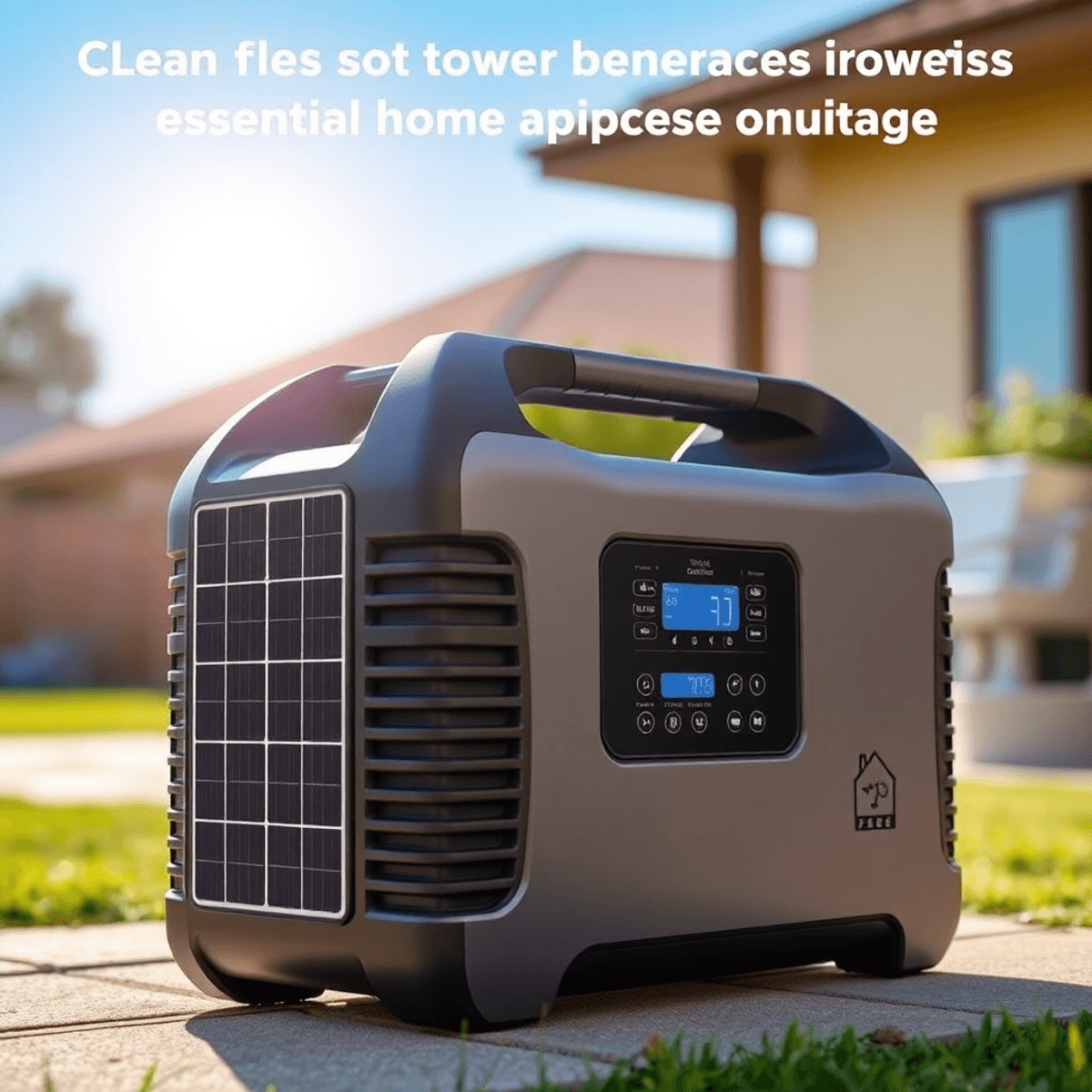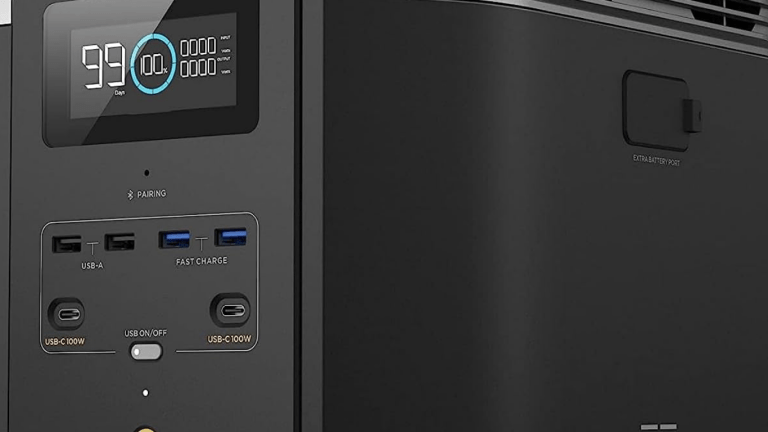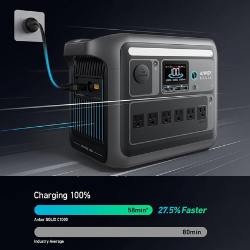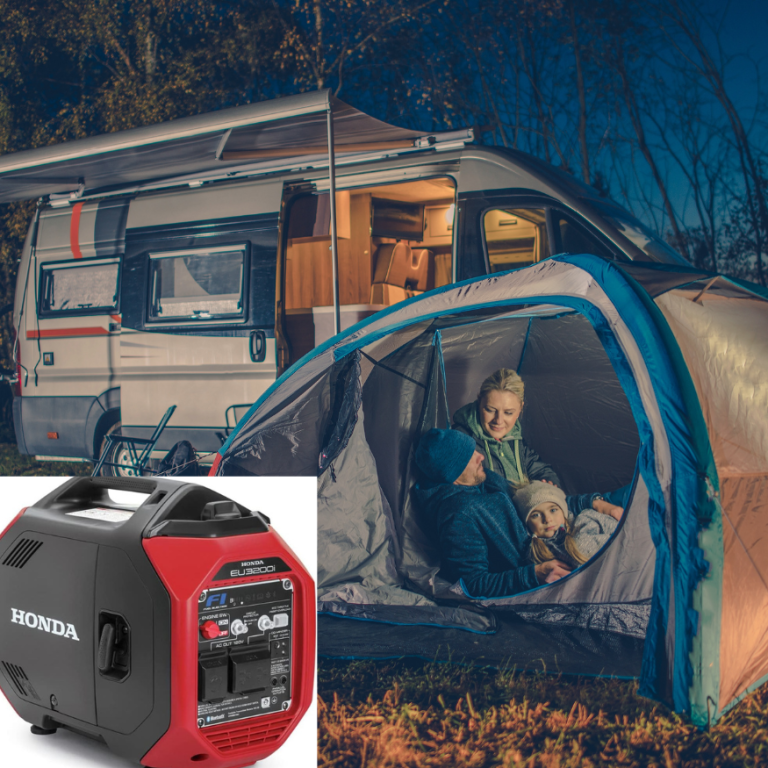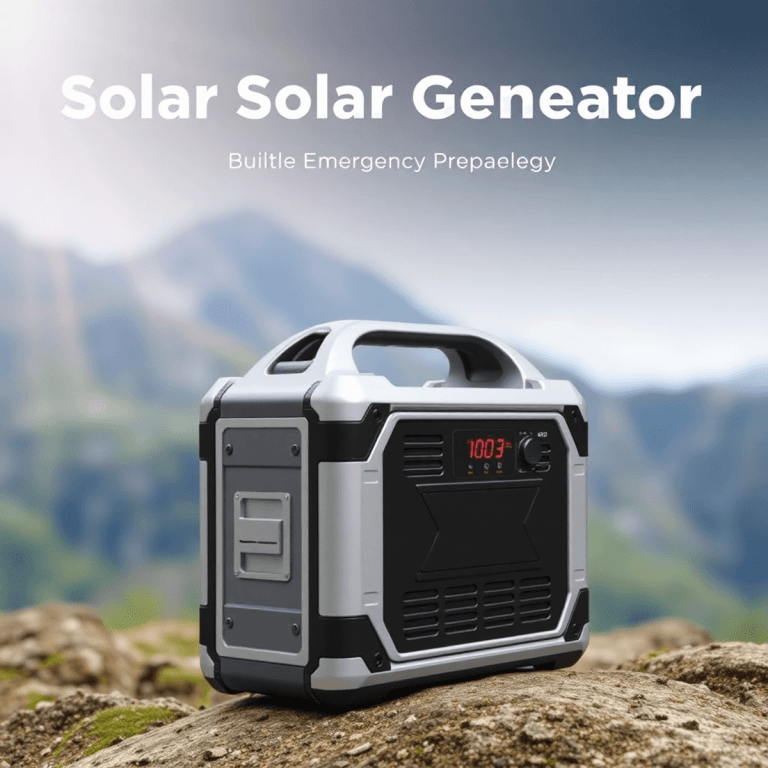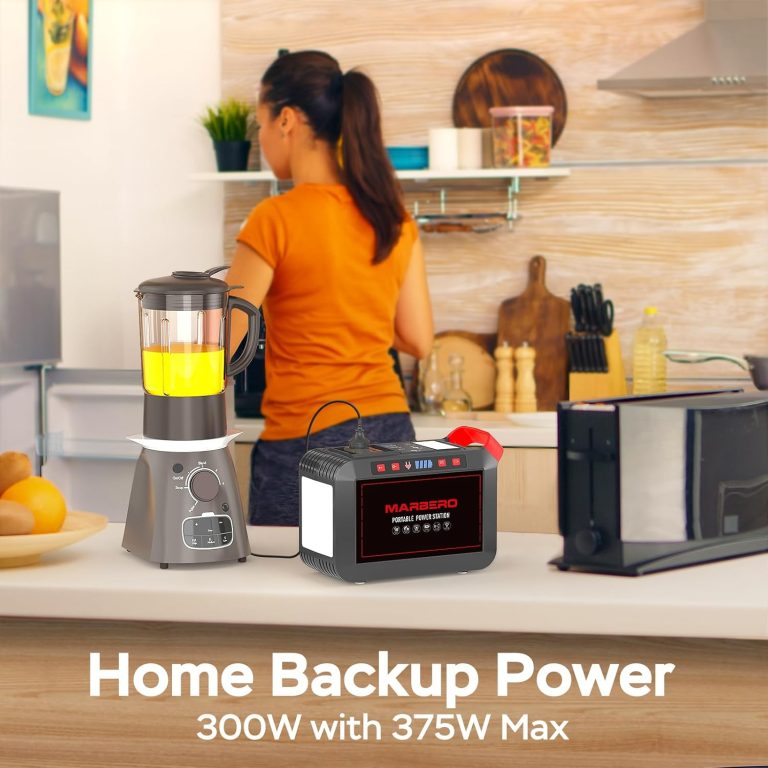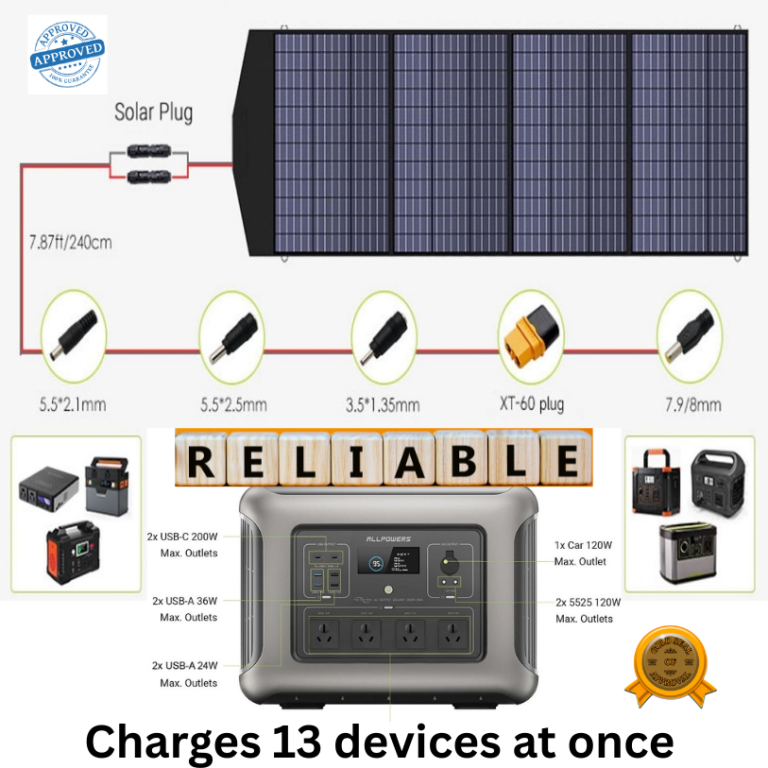How to Choose the Right Portable Solar Generator for Home Backup.
Portable Solar Generators: A Reliable Power Solution
A portable solar generator emerges as a dependable power source during unforeseen outages. These generators utilize modern battery technology and solar panels to establish a movable power station, ensuring the continuous operation of essential home appliances when conventional power sources are inaccessible.
Factors to Consider When Selecting a Generator
When choosing the ideal generator for your home backup requirements, several crucial factors come into play. Your decision impacts:
- The number of appliances you can power at the same time
- How long your backup power will last
- The speed at which the solar panels recharge the generator
- The amount of physical space needed for storage
- Your ability to move the unit when necessary
Key Factors to Consider When Choosing a Portable Solar Generator for Home Backup.
- Features: Look for models with smart home integration, longer battery life, and efficient charging.
- Reliability: Ensure the generator can power your home during emergencies.
- Environmental Impact: Opt for models that are environmentally friendly.
Selecting the right portable solar generator requires careful evaluation of several critical factors that directly impact its effectiveness as a home backup solution. Each factor plays a vital role in determining whether a generator meets your specific needs.
1. Power Output
Understanding the power requirements of your essential appliances is crucial when selecting a portable solar generator. Here are the key aspects to consider:
- Continuous Power Rating: Measure your essential appliances’ wattage requirements
- Peak Power Rating: Account for surge power needs during appliance startup
Example Requirements:
- Refrigerator: 400-800W
- Sump Pump: 800-1500W
- HVAC System: 1000-3500W
- LED Lights: 5-10W each
- Laptops/Mobile Devices: 45-100W
2. Energy Storage Capacity
The energy storage capacity of a portable solar generator determines how much power it can store for later use. To determine the appropriate capacity for your needs, follow these steps:
- Calculate daily power consumption in kilowatt-hours (kWh)
- Add 20% buffer for unexpected power needs
- Consider backup duration requirements:
- Short outages (1-2 days): 2-4 kWh
- Extended outages (3-7 days): 6-15 kWh
- Long-term backup: 15+ kWh
3. Weight and Dimensions
Portability is an essential factor when choosing a solar generator, especially if you plan to move it around frequently. Consider the following weight and dimension specifications:
- Portable Units: 12-25 kg (ideal for mobility)
- Semi-Portable Units: 25-45 kg (movable with wheels)
- Storage Space Requirements:
- Small units: 35x25x25 cm
- Medium units: 50x30x40 cm
- Large units: 65x35x50 cm
4. Inputs/Outputs
The types and number of ports available on a solar generator determine its versatility in powering different devices. Here are the essential ports and advanced features to look for:
Essential Ports:
- AC outlets (pure sine wave)
- USB-A and USB-C ports
- 12V DC outputs
- Solar input ports
Advanced Features:
- RV-ready outlets
- Anderson Powerpole connectors
- MPPT charge controllers
5. Solar Charging Capabilities
When selecting a portable solar generator, it’s important to consider its solar charging capabilities as this will determine how quickly you can recharge the battery using solar panels. Here are some factors that affect charging speed:
Maximum Solar Input Power
Check the manufacturer’s specifications for the maximum solar input power rating of the generator. This indicates how much power it can receive from solar panels during charging.
Number and Type of Solar Panels
The number and type of solar panels you plan to use in conjunction with the generator will also impact charging speed. Higher wattage panels will generate more electricity, resulting in faster recharging times.
Sunlight Exposure
The amount of sunlight exposure at your location plays a significant role in determining how efficiently solar panels convert sunlight into electricity. Ensure that you have adequate sunlight exposure for optimal charging performance.
By considering these key factors – power output, energy storage capacity, weight and dimensions, inputs/outputs, and solar charging capabilities – you can make an informed decision when choosing a portable solar generator for home backup in 2025.
Choosing the Right Battery Technology for Your Portable Solar Generator.
Battery technology is crucial for the performance of your portable solar generator. The type of battery used will affect how long the system lasts, how safe it is to use, and how well it works in different situations.
LiFePO4: The Best Choice for Home Backup.
LiFePO4 (Lithium Iron Phosphate) batteries have become the top choice for portable solar generators in 2025. Here’s why they are superior:
1. Enhanced Safety Features
- Built-in protection against overheating
- No risk of uncontrolled temperature increase
- Safe operation in extreme temperatures, thanks to their wide operating temperature range
2. Longer Lifespan
- More than 3,000 charging cycles until it reaches 80% capacity
- Over 10 years of regular usage
- Minimal decrease in capacity over time
Comparing Battery Technologies.
Let’s see how LiFePO4 compares to other common lithium-ion batteries:
| Feature LiFePO4 NMC LCO Cycle Life | 3,000+ | 1,000 | 500 |
| Temperature Tolerance | High | Moderate | Low |
| Energy Density | Good | Better | Best |
| Safety | Excellent | Good | Fair |
Performance Under Pressure.
LiFePO4 batteries perform exceptionally well in challenging situations:
- Stable power supply even with heavy usage
- Consistent performance in cold weather conditions
- Fast charging capabilities (0-80% charge in 2 hours)
- Minimal energy loss when not in use
These benefits make LiFePO4 batteries especially suitable for home backup situations where dependability and long-lasting power are essential. Their strong chemical composition ensures that your power system remains functional when you need it the most, whether during long power outages or daily usage.
Exploring Different Solar Panel Technologies for Portable Solar Generators.
Solar panel technology is the foundation of any portable solar generator system. The choice of panels directly affects how quickly your generator charges, how efficiently it operates, and how well it performs in different lighting conditions.
Monocrystalline Panels: The Gold Standard
Monocrystalline panels are the top choice in 2025, with efficiency ratings reaching 22-23%. These panels offer:
- Higher power output per square foot
- Better performance in low-light conditions
- Sleek, space-saving designs
- Enhanced durability in harsh weather
Performance Characteristics
A 200W monocrystalline panel can generate:
- 1kWh of energy in 5-6 hours of sunlight
- Reliable power even under partial shade
- Consistent output in temperatures up to 85°F (29°C)
Space-Efficient Design Features
Modern monocrystalline panels for portable generators come with practical design elements:
- Foldable configurations for easy storage
- Lightweight aluminum frames
- Built-in kickstands for optimal sun angle
- Weather-resistant junction boxes
- Anti-reflective glass coating
The latest monocrystalline panels incorporate bifacial technology, capturing reflected light from both sides. This feature increases energy production by 5-15% in optimal conditions, making them particularly effective for home backup scenarios where maximum power generation is crucial.
These advanced panels pair seamlessly with smart MPPT charge controllers, optimizing charging speeds throughout the day. You’ll find this combination particularly beneficial during winter months or overcast conditions when sunlight intensity varies.
Examining Design Features That Enhance Functionality and Portability in Portable Solar Generators.
Design features directly impact how you interact with your portable solar generator daily. Smart design choices can transform a basic power station into a versatile, user-friendly energy solution that grows with your needs.
Modular Design Benefits:
- Expand battery capacity without replacing entire unit
- Add solar panels as energy requirements increase
- Mix and match components based on seasonal needs
- Reduce upfront costs by starting with basic setup
The latest portable solar generators embrace modular architecture, letting you stack additional battery packs or connect extra solar panels. This adaptability proves invaluable as your power needs evolve – you can start with a 1kWh system and scale up to 25kWh by adding expansion batteries.
Key Design Elements:
- Quick-connect ports for hassle-free expansion
- Hot-swappable batteries for uninterrupted power
- Integrated handles and wheels for easy transport
- Compact footprint to maximize storage space
- Weather-resistant construction for outdoor use
Improved Text:
Enhanced Control Panels and Safety Features
Modern units come with user-friendly control panels that offer real-time power monitoring. Touch screens conveniently show battery levels, charging status, and power consumption instantly. They also include essential safety features such as overcharge protection and temperature control to guarantee dependable operation and system expansion.
Modular Design for Easy Maintenance
The modular design simplifies maintenance by allowing the replacement of individual components instead of the entire system. This approach not only prolongs the lifespan of your investment but also offers the flexibility to adjust to evolving energy needs effectively.
In addition, the integration of advanced technologies such as those found in uninterruptible power supplies (UPS), further enhances the functionality of these portable solar generators, ensuring that you always have access to reliable power regardless of external conditions.
Choosing a Portable Solar Generator for Home Backup.
When selecting a portable solar generator for home backup, it’s crucial to consider practical aspects beyond just specifications.
Technical specifications tell only part of the story when selecting a portable solar generator. Real-world usage factors play a crucial role in your daily experience with these devices.
Noise Levels Matter
You might assume solar generators operate silently – this isn’t always true. Different models produce varying noise levels:
- Cooling Fans: High-capacity units often use multiple cooling fans that can reach 60-70 decibels
- Inverter Operation: Pure sine wave inverters can emit a low humming sound
- Battery Management Systems: Some models produce clicking sounds during charge regulation
Smart Features and Connectivity.
Modern portable solar generators come equipped with advanced monitoring capabilities:
- Mobile Apps
- Real-time power consumption tracking
- Battery health monitoring
- Remote shutdown/startup options
- Custom charging schedules
- Firmware updates
- Display Interfaces
- LCD screens showing power flow
- Battery percentage indicators
- Error code notifications
- Input/output status
Weather Resistance and Durability
2025 models feature enhanced protection against environmental factors:
- IP65 water resistance ratings
- UV-resistant exterior coating
- Rust-proof connection ports
- Temperature-adaptive performance (-20°C to 45°C)
Maintenance Requirements
Different models demand varying levels of upkeep:
- Regular TasksDust removal from vents
- Port cleaning
- Software updates
- Battery conditioning cycles
These practical considerations directly impact your user experience and long term satisfaction with your portable solar generator. The right combination of features creates a reliable power backup system that meets your specific needs.
Popular Home Backup Solutions.
When choosing a home backup solution, it’s essential to consider the key features that each option offers. Here are some popular choices to help you make an informed decision:
Leading brands in portable solar generators have established their reputation through consistent performance and reliability. Let’s examine three standout options in the market:
Eco Flow DELTA Series
- DELTA Pro: 3.6kWh-25kWh expandable capacity
- DELTA Max: 2kWh-6kWh storage options
- DELTA 2: Perfect for smaller homes at 1kWh-2kWh
Jackery Explorer Series
- Explorer 2000 Pro: 2kWh capacity with 2,200W output
- Explorer 1000 Pro: 1kWh storage with fast charging
- Built-in MPPT controller for efficient solar charging
Goal Zero Yeti
- Yeti 6000X: 6kWh capacity for whole-house backup
- Yeti 3000X: 3kWh storage with 2,000W output
- WiFi connectivity for remote monitoring
These systems offer varying capacities and features to match different home backup needs. Each brand provides unique advantages – Eco Flow excels in expandability, Jackery focuses on portability, Goal Zero emphasizes user-friendly interfaces.
Choosing the Right Portable Solar Generator for Your Home Backup.
When considering a portable solar generator for your home backup needs, there are several key factors to keep in mind. Let’s explore some essential aspects to help you make an informed decision.
Choosing the right portable solar generator requires a careful process to balance your specific needs with available options. Here’s a practical decision-making framework:
1. Calculate Your Power Requirements
- List essential appliances and their wattage
- Determine desired backup duration
- Add 20% buffer for unexpected needs
2. Set Your Budget Parameters
- Initial purchase cost
- Potential tax incentives
- Long-term maintenance expenses
3. Create Your Must-Have Features List
- Minimum power output
- Battery capacity
- Charging options
- Smart features
4. Compare Top Contenders
- Match features against your requirements
- Read user reviews for real-world performance
- Check warranty terms
Your ideal portable solar generator should align with your:
- Daily energy consumption patterns
- Available storage space
- Local climate conditions
- Future expansion needs
Choosing the Right Generator
- Prioritize Functionality Over Price:
- Opt for a mid-range generator that meets your needs effectively rather than an expensive model with extra features you don’t require.
- Research and Compare:
- Take the time to research different options, compare their specifications, and choose a generator that offers reliable backup power within your budget.
Consider Fuel Efficiency
Look for generators that offer good fuel efficiency, as this can help reduce running costs over time.
Noise Levels
If noise is a concern, opt for a generator with lower decibel levels or one that features noise-reducing technology.
Warranty and Support
Check the warranty offered by the manufacturer and ensure they have a reliable customer support system in place.
Installation and Maintenance
Consider the ease of installation and ongoing maintenance requirements of the generator before making a decision.
By carefully considering these factors, you can select a backup generator that not only meets your power needs but also offers long term reliability and cost effectiveness.

